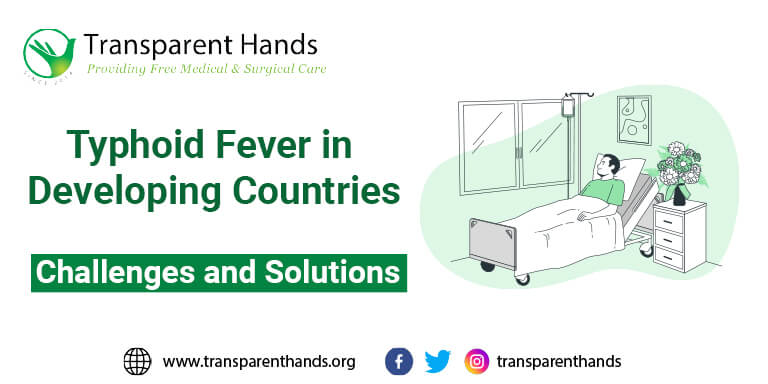Typhoid Fever in Developing Countries: Challenges and Solutions

Typhoid outbreaks have great effects on developing countries, both in terms of their health and their economy. The World Health Organization (WHO) data from 2019 estimates that about 9 million cases of typhoid fever occur each year, with the majority occurring in developing countries. Each year, approximately 110,000 people die from this illness, with the highest disease burden in the African, Eastern Mediterranean, South-East Asia, and Western Pacific regions.
Typhoid outbreaks can have serious economic consequences for developing countries. The fever can be costly to treat, especially if the patient requires hospitalization. Children in developing countries are especially vulnerable to typhoid. If they’re under five, they are more likely to contract the disease and suffer from severe complications.
Typhoid Fever Prevention Challenges
1. Limited Access to Clean Water and Sanitation Facilities
One of the most significant challenges in preventing and controlling typhoid outbreaks is a lack of adequate infrastructure for clean water and sanitation facilities in developing countries. Many people in these countries are forced to rely on contaminated water or open defecation, which can contribute to the spreading of disease. Also, waste management systems that aren’t effective can pollute the environment and cause the disease to spread.
2. Weak Healthcare Infrastructure
In many developing nations, the inadequate healthcare infrastructure makes it difficult to detect, diagnose, and treat typhoid. Inadequate laboratory facilities and a lack of medical personnel can cause diagnostic delays, while limited access to vaccines and antibiotics can worsen patient outcomes.
3. Limited Public Awareness
In developing nations, managing and preventing typhoid outbreaks is further complicated by a lack of public awareness and education. Many people in these countries are unaware of the dangers of typhoid or how to avoid it.
4. Economic Barriers
The cost of treatment for typhoid fever can be high, particularly for patients who require hospitalization. For many families living in poverty in developing countries, the cost of treatment can be an overwhelming burden that leads to decreased access to essential healthcare services. Additionally, outbreaks can have indirect costs, such as lost productivity due to illness and decreased economic activity due to fear of infection.
5. Antibiotic Resistance
Antibiotic resistance is a growing concern in the management of typhoid in developing countries. Overuse and misuse of antibiotics can lead to the development of antibiotic-resistant strains of the disease, which can make it more challenging to treat infections and can lead to increased morbidity and mortality.
6. Political Instability and Conflict
In developing countries, typhoid outbreaks can be hard to control because of political instability and social conflicts. These factors can cause disruptions in healthcare services, population displacement, and reduced access to clean water and sanitation facilities. Additionally, armed conflict can impede access to medical supplies, personnel, and other essential resources.
Typhoid Prevention in Developing Countries
1. Improving Access to Clean Water and Sanitation Facilities
The most effective way to prevent typhoid is to improve access to clean water and sanitation facilities. Governments and organizations should invest in building and maintaining infrastructure to provide clean water and sanitation facilities to communities.
2. Strengthening Healthcare Infrastructure
Developing countries must strengthen their healthcare infrastructure by increasing the number of trained medical personnel and equipping hospitals and clinics with the necessary equipment and supplies to diagnose and treat typhoid fever. Additionally, governments and organizations should invest in laboratory facilities to diagnose the disease accurately.
3. Promoting Public Awareness
Developing countries must prioritize educating the public about the risks of typhoid and how to prevent it. Health authorities should use various communication channels, including social media and community events, to promote awareness of the disease and ways to prevent it.
4. Increasing Access to Vaccines and Antibiotics
Developing countries should work to improve access to typhoid vaccines and antibiotics. Governments and organizations should invest in vaccination campaigns that target vulnerable populations, such as children and people living in typhoid-prone areas.
5. Addressing Antibiotic Resistance
Countries in development must take measures to prevent the emergence of typhoid fever strains that are resistant to antibiotics. Authorities in the field of public health should promote the proper use of antibiotics and intensify efforts to monitor and control the spread of antibiotic-resistant strains.
6. Addressing Economic Barriers
Developing countries must address the economic barriers to preventing and treating typhoid. Governments and non-profit organizations should consider subsidizing vaccines and antibiotics to make them more affordable for vulnerable populations.
Conclusion
Typhoid fever is still a major public health issue in developing countries, including Pakistan. Lack of access to clean water, inadequate sanitation, and limited healthcare resources all contribute to the spread of disease. Efforts to prevent and control typhoid fever, such as improving water and sanitation infrastructure and increasing vaccine access, can, however, make a significant difference. One example of a positive initiative in Pakistan is Transparent Hands, an online platform that allows individuals to donate money to help fund surgeries and medical treatments for patients in need. Giving online donations to any healthcare organization can help tackle the problems caused by typhoid fever in developing nations and enhance the lives of those who suffer from the illness.










Leave Your Comments